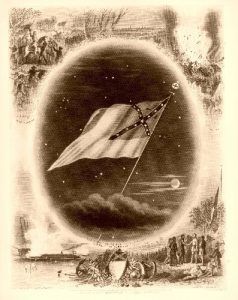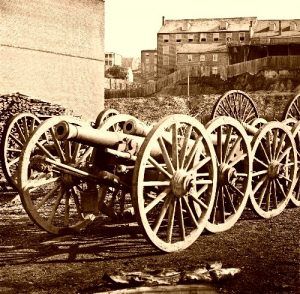By Paul R. Petersen, author of Quantrill of Missouri
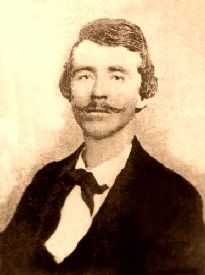
William Quantrill
Loved and respected by his men, hated and feared by his enemies, adored by the young Southern women who he met, and befriended by those who sought justice and protection. This is William Clarke Quantrill.
— Paul R. Petersen on Quantrill
William Clarke Quantrill was a product of his times. He was a man made up of the personalities, passions, and politics that surrounded him. Without the issue of slavery that ignited the nation and the turbulent individuals like John Brown and James Henry Lane that inflamed the border of Kansas and Missouri, history would never have recorded his name. To study the history of the border warfare between Kansas and Missouri is also to study the character of the people living there at the time. However meaningless, a slight provocation was taken as a personal insult and could wind up in a feud, a personal duel, or a lifetime of personal hatred between offending parties. There was a conflict along the border long before there was hatred and bloodshed. It was here that men, controlled by personal pride and patriotism, lived and in whose homes, hospitality and generosity were a way of life. Conflict arose between those already established in the region and those Northern emigrants from the large cities of the North who came west in hopes of an easy life and quick fortune. Most of the settlers along the border at this time were opportunists. Life was hard, and a chance to earn money to stay alive didn’t come along every day. Many sought opportunities in honest endeavors, while others sought a dollar in any way that offered a lucrative deal. Some sought their fortune in the new political future along the border, and some sought their fortune in the law. But for everyone who sought an honest living, ten others were looking to make a quick dollar by jumping someone else’s land claim, larceny, or deceit. These incompatible sectional differences only made the growing conflict between Missourians and Kansans more unenduring.
Most stories about Quantrill are merely lies. How could a single human being be written about in history as the devil incarnate, without love for either of his parents or family and whose own mother was declared to be a mother in name only, showing no love for her son? Author William Elsey Connelley said that Quantrill’s father was an embezzler and thief and was looked down upon by his neighbors. Quantrill was described as fiendish for skinning neighbor’s cats and shooting pigs through their ears to listen to them squeal. Connelley reported that when Quantrill courted young women, his talk would turn sadistic as he commented how many men he could hang from certain tree limbs. In his life in Kansas before the Civil War, he was described as being shiftless and without a visible means of support, even stealing from his neighbors and local merchants. He was called a bloodthirsty killer, murdering and stealing from those in Missouri and Kansas.
Connelley said that no one in Quantrill’s band trusted him, and he made them nervous and edgy. It was said he had a mistress, and after the war, she opened a house of prostitution in St. Louis. When the war was coming to a close, Quantrill was even said to have made plans to go to Washington, D.C., to kill President Lincoln. Historical evidence has never supported these accounts. Many scholars, who knew of Connelley’s intent and had read portions of his manuscript before publication, warned him against his “extreme statements,” but they were ignored. The contradictions discovered were based on hearsay, lies, half-truths, and outright distortions.
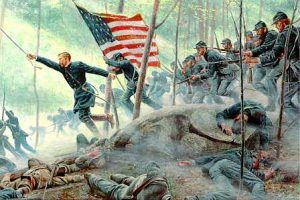
Civil War
How could this so-called fiend have been a respected schoolteacher? How could he have organized and led up to 400 men in history’s most notable band of guerrilla fighters? Why did regular Confederate army officers who outranked him yield to him and place themselves subordinate to his command? How could he be so hated by his own men and still lead them in the van of the most renowned battles throughout Missouri, winning victories over superior Union forces?
Mothers entrusted their sons to him. Citizens served him as spies. Women willingly nursed him and his men, while his followers were intensely loyal to him, even guarding him in battle. Most of his followers were God-fearing farmers trying to live a Christian lifestyle. Critics may point out that associating upright; righteous people wouldn’t necessarily make Quantrill the same. But from experience, God-fearing, righteous people would not have followed a depraved, degenerate, psychotic killer.
After the war, one of Quantrill’s men stated, “You who were not there can not realize for a moment the dreadful passions that were roused in the hearts of men during those fearful years.” The Missouri border during the Civil War was the scene of the greatest savagery in American history. Never before or since have Americans exhibited such brutality toward their fellow Americans. The controversy surrounding William Clarke Quantrill is nothing less than a scandal. At the time, the Northern press conspired to blacken his name and those of his followers, a conspiracy that continues even today.
Captain William Gregg, Quantrill’s adjutant, reported in a letter after the war that “Quantrill and his men have been unjustly slandered by the people of the North, a people who, even to this day, know nothing of them, except what they have read in irresponsible books and newspapers.” Gregg says, “It is not enough that their valor is recognized; it is not enough that their honesty is confessed. We ask of our Northern brother; we ask of all mankind and all womankind a recognition of their patriotism, their love of country, and liberty…we cannot remain silent so long as the pen of the historian casts any aspersion, or the tongue of the orator upon their patriotic motives, or the loftiness of their purposes throughout that mighty struggle. We make no half-hearted apologies for their acts. It is justice for which we plead, not charity.”
Colonel R. H. Hunt, who served in the Union army fighting against Captain Gregg, said of him after the war, “That in so far as his memory serves him, his statements can be depended upon absolutely. He is a man who would not willfully misrepresent.”
Quantrill did not act alone, and his followers suffered a similar mischaracterization. According to the Northern press, every guerrilla was a bloodthirsty, brutal, psychotic killer. Their relatives were low-class individuals and criminally natured, and their women were said to have loose morals. Historians refuse to acknowledge that Quantrill and his men were soldiers; instead, they refer to them as outlaws. From this perspective, Quantrill’s partisan ranger band could not be credited with winning a military victory in open battle, so they became bloodthirsty killers who murdered and massacred their victims. These accounts were written down through history by a victorious enemy over a beaten but unbowed foe. John McCorkle, one of Quantrill’s men, wrote a book about his experiences with Quantrill, explaining that it was “not published in any spirit of malice or hatred, but so that the truth may be known, that the world may know that Quantrill and his band were justified in nearly all of their acts and that they were not altogether bad; that they were driven to desperation by brutal outrages committed against them and their friends….” Likewise, Captain Gregg wrote that “History after history has been written of Quantrill and his men, none of which can be characterized as true. And that which is not true is not history.”
Our understanding of the Civil War is largely viewed through the eyes of the victors. Still, most inhabitants along the western border were Southern sympathizers, and their viewpoint has been generally ignored. By today’s standards of conduct and values, there is no way to clearly understand the surroundings and character of the men on the western border. Ideals such as chivalry and good manners, including kindness towards those younger and weaker, was an ideal that kept the fabric of their society together. Integrity was paramount for a respectful character. Pride, honor, devotion: these intrinsic values which have all but lost their importance, except to a chosen few in today’s society, meant everything to the men who had but these values to fight and die for. Everything else they held dear and sacred was taken from them by the government supposed to protect them.
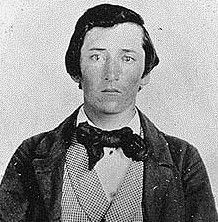
William Quantrill
Everything about Quantrill’s life has been greatly distorted by prejudicial historians and journalists. The hatred of his Kansas enemies and of those he fought against during the war were manifested in writings and were grossly exaggerated by those who had never come face to face with him. Only sensational claims previously heard by those who had cause to try to blacken his name because of their own political views and sectional feelings have been noted for history. Quantrill’s critics have painted him in the worst possible light and have collectively and in collusion told unfounded and unproven stories of him.
Many past writings on Quantrill have been written by Kansas and Northern writers and others, without military backgrounds or experiences to draw upon, merely capitalizing on the sensationalism of fictionalized accounts about Quantrill and his men. Many repeat the same worn-out rumors and inaccuracies and still claim that they have done exhaustive research. A modern military saying is: “For those who fight for it, freedom has a flavor the protected never taste.” This experience is much more beneficial when books are written by actual combat veterans compared with those authors who have never had any military experiences or those who have never walked over the same ground or are familiar with the area known as “Quantrill Country”.
By viewing Quantrill through different eyes we can see him as he really was: an educated and moral young man who began his career protecting the lives and property of the people who were daily being robbed and killed by an enemy who was hiding their criminal deeds behind the cloak of a flag that they used for their own selfish greed and ambitions. We should seek to dignify his life, not to romanticize it.
Loved and respected by his men; hated and feared by his enemies; adored by the young Southern women who he met, and befriended by those who sought justice and protection: this was William Clarke Quantrill. This is the truth behind the man and the soldier.
© Paul R. Petersen, December 2004. Updated February 2023.
Readers Comment:
Perhaps the author of this article would be interested to know that Will Gregg, a relative my Grandpa Purcell knew (Grandpa was born in 1900), is not well respected in our family. Grandpa referred to him as the meanest S.O.B. he’d ever known. By contrast, that same grandpa remembered Cole Younger (also a relative) being at a family picnic and his sister being bounced on his knee – thought him to be a very kind old man. So we’re hardly misguided Kansans out to smear Quantrill and his men, nor are we apologists for them – Cole is well-liked in our family (he did his time and was returned to society), but Gregg is not… and both were relatives. I doubt Gregg’s word can be trusted as to the character of Quantrill… and trying to dismiss the raid on Lawrence as the writer does is hardly good historical scholarship. – Tom Miller, May 2013
About the Author: Paul R. Petersen is a lifelong resident of Jackson County, Missouri, the same area in which William Clarke Quantrill’s partisan rangers operated. A highly decorated Master Sergeant in the United States Marine Corps and a combat infantry veteran of Vietnam and Desert Storm, Petersen is uniquely qualified to interpret the nature of guerrilla warfare that characterized the Civil War along the Missouri-Kansas border. He lives in Raytown, Missouri. His recent book Quantrill of Missouri by Cumberland House Publishing is his first book in a trilogy concerning Quantrill during the Civil War.
Also See:
Bleeding Kansas and the Missouri Border War
Lawrence, Kansas – From Ashes to Immortality
The True Account of William “Bloody Bill” Anderson
William Quantrill – Renegade Leader of the Missouri Border War

